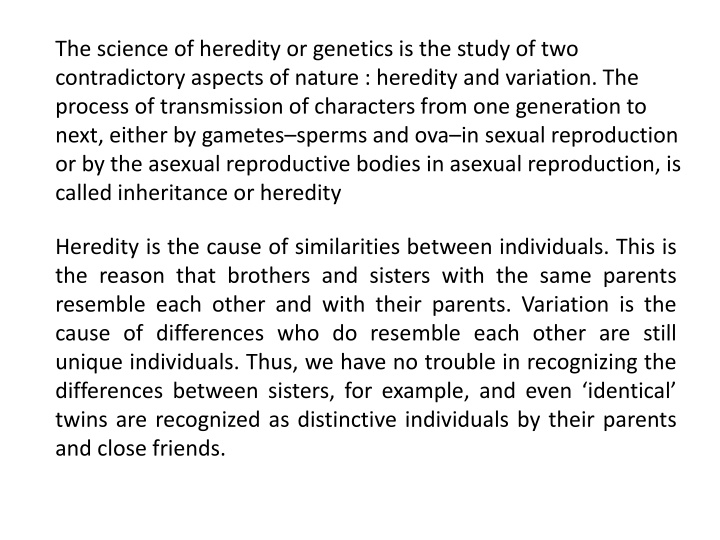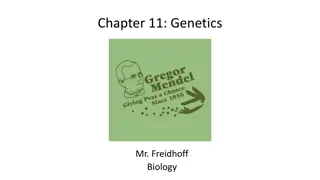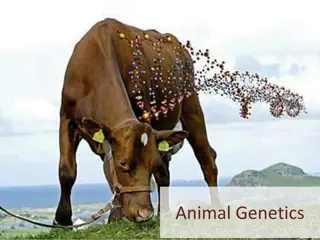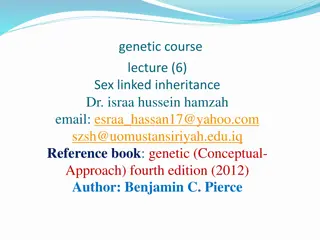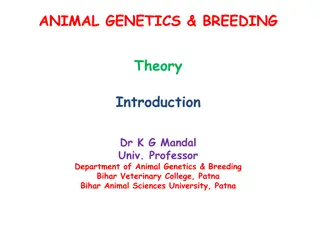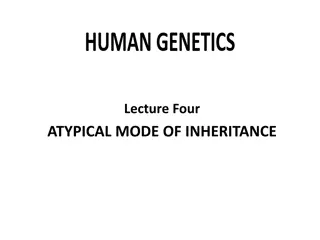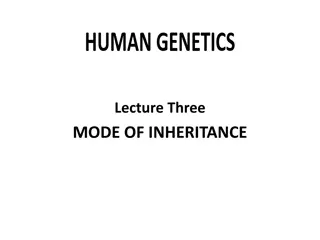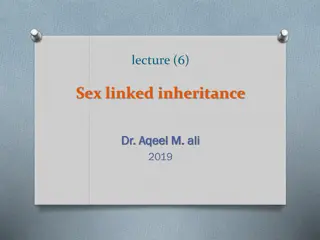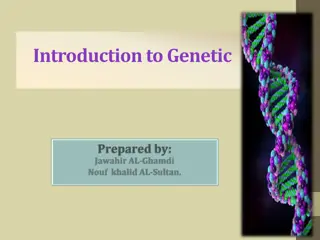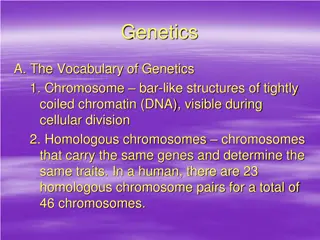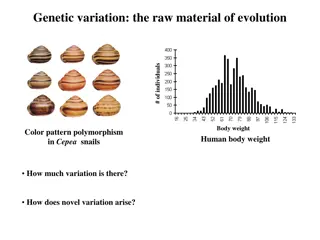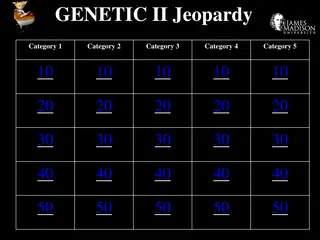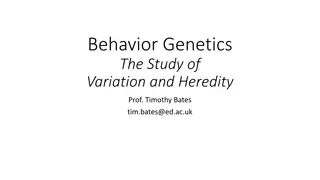The Science of Heredity and Genetics: Understanding Inheritance and Variation
The science of heredity and genetics delves into the transmission of traits from one generation to the next, exploring the causes of similarities and differences between individuals. Through the study of genetics, we uncover the mechanisms behind evolution, speciation, and cytodifferentiation in living organisms, shedding light on how heredity shapes similarities and variations in species.
Download Presentation

Please find below an Image/Link to download the presentation.
The content on the website is provided AS IS for your information and personal use only. It may not be sold, licensed, or shared on other websites without obtaining consent from the author.If you encounter any issues during the download, it is possible that the publisher has removed the file from their server.
You are allowed to download the files provided on this website for personal or commercial use, subject to the condition that they are used lawfully. All files are the property of their respective owners.
The content on the website is provided AS IS for your information and personal use only. It may not be sold, licensed, or shared on other websites without obtaining consent from the author.
E N D
Presentation Transcript
The science of heredity or genetics is the study of two contradictory aspects of nature : heredity and variation. The process of transmission of characters from one generation to next, either by gametes sperms and ova in sexual reproduction or by the asexual reproductive bodies in asexual reproduction, is called inheritance or heredity Heredity is the cause of similarities between individuals. This is the reason that brothers and sisters with the same parents resemble each other and with their parents. Variation is the cause of differences who do resemble each other are still unique individuals. Thus, we have no trouble in recognizing the differences between sisters, for example, and even identical twins are recognized as distinctive individuals by their parents and close friends.
Heredity is the cause of similarities between individuals. This is the reason that brothers and sisters with the same parents resemble each other and with their parents. Variation is the cause of differences who do resemble each other are still unique individuals. Thus, we have no trouble in recognizing the differences between sisters, for example, and even identical twins are recognized as distinctive individuals by their parents and close friends. The science of genetics attempts to explain the mechanism and the basis for both similarities and differences between related individuals. It also tries to explain the phenomenon of evolutionand cytodifferentiation
The science of genetics is the study of heredity which is the cause of similarities; and variation which is the cause of differences between individuals . The heredity and variations play an important role in the formation of new species (speciation). The biological science which deals with the mechanism of heredity and causes of variations in living beings(viruses, bacteria, plants and animals) is known as genetics. The word genetics was derived from the Greek root gen which means to become or to grow into and it was coined by Bateson in 1906 for the study of physiology of heredity and variations.
The science of genetics attempts to explain the mechanism and the basis for both similarities and differences between related individuals. It also tries to explain the phenomenon of evolutionand cytodifferentiation The science of genetics is the study of heredity which is the cause of similarities; and variation which is the cause of differences between individuals The heredity and variations play an important role in the formation of new species (speciation). The biological science which deals with the mechanism of heredity and causes of variations in living beings(viruses, bacteria, plants and animals) is known as genetics. The word genetics was derived from the Greek root gen which means to become or to grow into and it was coined by Bateson in 1906 for the study of physiology of heredity and variations.
Importance of genetics The cultural evolution of human beings is strongly influenced by knowledge of hereditaryLong before biology existed as ascientific discipline, peopleselected grains with higher yields andgreater vigor and animals with better fur, meat or milk. Despite this longstanding concern with heredity and the practice of selective breeding, it was not until the discovery of Mendel s laws that we were able to explain the actual basis for inheritance. such successes led to the concept of GreenRevolution . Using sophisticated breeding techniques based on new knowledge about genes, geneticists created high-yielding varieties of dwarf wheat and rice. Large-scale planting of these crops around the world did provide new food supplies,
advances in biotechnology have led to the creation of special genetically engineered strains of bacteria and fungi that carry specific genes from unrelated organisms such as humans. (Note: Biotechnology means use of living organisms or processes to modify or make products and to improve plants or animals,). these microbes produce such useful compounds as insulin, human growth hormone and the antiviral (or anticancer) agent the interferon. Further, the most exciting and alarming application of genetic knowledge is to the human speciesitself. Genetic discoveries have had major effects on medicine. One can now diagnose hereditary orgenetic disease before or soon after birth, and in some cases we can provide secondary treatments. Using family pedigree analysis, a genetic counselor can give prospective parents the information they need to make intelligent decisions about the risks of genetic disease in their offspring.
Mendel and His Work Johann Mendel was the pioneer of classical geneticists.He was born in July 22,1822 in Heinzendorf in AustrianSilesia, where his father, Anton Mendel was the owner ofa small farm. In 1862, Mendel became a founding member of the Brunn Natural Science Society. On February 8, 1865, he delivered his first lecture on pea experiments to Brunn Natural Science Society. In 1866 his paper Experiments on plant hybridization published in volume 4 of the proceedings of the Natural Science Society. In the same year, he began experiments with other plant species. In this paper, Mendel proposed some basic genetic principles. But unfortunately his remarkable piece of work remained unattended and unappreciated up to 1900.
There were several reasons for the sad neglect of Mendel's work. These include 1- biologist's preoccupation with speculation concerning Darwin's theory of evolution origin of species which appeared in 1859 2- obscurity of the journal in which Mendel published his results; REDISCOVERY OF MENDEL'S WORK Mendel's research paper remained dormant and unnoticed by the scientific world until 1900. During these intervening thirty four years many developments occurred in biology which prepared the way for the rediscovery of Mendel's work. For instance, during this period Haeckel (1866) recognised the active role of nucleus in heredity; Weismann, Hertwig, Strasburger and Kolliker suspected active participation of chromosomes in heredity transmission. Roux (1883 suggested that the chromosomes must contain qualitatively different hereditary determiners arranged in linear orders. Weismann supported the idea of Roux by propounding his germplasm theory
Further, some workers such as Darwin (1868) in England Vilmorin(1879) in France, Rumpau (1891) in Germany and Bohlin (1897) in Sweden carried out hybridization experiments, very much like Mendel, on different plants and observed the phenomenon of dominance, but they failed to provide any conclusive explanation to their findings. It was in the beginning of 20th century that three botanists, namely Hugo de Vries, working onOenothera; Carl Correns working on Xenia, peas and maize and Erich von Tschermak working on various flowering plants, independently drawn the conclusions like Mendel. Later these botanists cameacross the research paper of Mendel and rediscovered it in 1900. Mendel s original paper was republished in Flora, 89, 364 (1901). Bateson confirmed Mendel s work by a series of hybridizationexperiments.
MENDELS SELECTION OF THE EXPERIMENTAL PLANT. For his hybridization experiments Mendel had certain consideration in his mind about the choiceof a suitable material. Mendel s considerations about the material were as follows : 1- Variation. The organisms which are to be chosen for thegenetical experiments, should have a number of detectable differencesand at a time only single detectable character should be considered. 2- .Reproduction. The chosen organisms should be sexually reproducing 3-Controlled mating. 4-Short life cycle.
5-Large number of offsprings. 6-Convenience in handling. The experimental species should be of a type that can be raisedand maintained conveniently andinexpensively in the laboratory.For instance, the elephant will proveentirely useless material for genetical experiments than the Drosophila, pea plants, tomato, rats, guineapigs, etc., which have been generally used and are still used in hybridization experiment Mendel s Experiments: Mendel found edible pea (Pisumsativum) a best material for his hybridization experiments. Thepea plant has various contrasting characters among its different varieties such as stem may be tall ordwarf, cotyledons may be green or yellow;
seeds may be round or wrinkled, seed coat may be colouredor colourless; the unripe pods may be green or yellow; the ripe pods may be inflated or constrictedbetween the seeds, flowers may have axial or terminal positions and the colors of flowers may be redor white. Besides these contrasting characters, the pea plant is a very satisfactory material for the hybridization experiments due to its flower structure. The flowers of pea plants are so constructed thatthe pollens of a flower normally fall on the stigma of the same flower and, thus, affects self-pollinationor self-fertilization. For the required cross-pollination, the anthers have to be removed from the flowerin bud stage (i.e., before their maturity). This operation of removal of anthers is called emasculation.The stigma is protected against any foreign pollen with the help of its covering by a bag. The pollen,
then at the dehiscence stage is brought from the plant to be used as a male parent and by the help of abrush is dusted on the feathery stigma of the emasculated flower. At the time of such cross pollination,the pollen should be mature and stigma should be receptive.
Principle of Segregation Mendel studied the inheritance of seed shape first. A cross involving only one trait is referred to as a monohybrid cross. Mendel crossed pure-breeding (also referred to as true-breeding) smooth-seeded plants with a variety that had always produced wrinkled seeds (60 fertilizations on 15 plants). All resulting seeds were smooth. The following year, Mendel planted these seeds and allowed them to self-fertilize. He recovered 7324 seeds: 5474 smooth and 1850 wrinkled. To help with record keeping, generations were labeled and numbered. The parental generation is denoted as the P1 generation. The offspring of the P1 generation are the F1 generation (first filial). The self-fertilizing F1 generation produced the F2 generation (second filial).
Inheritance of two alleles, S and s, in peas. Image from Purves et al., Life: The Science of Biology, 4th Edition, by Sinauer Associates (www.sinauer.com) and WH Freeman (www.whfreeman.com), used with permission
Punnett square explaining the behavior of the S and s alleles. Image from Purves et al., Life: The Science of Biology, 4th Edition, by Sinauer Associates (www.sinauer.com) and WH Freeman (www.whfreeman.com), used with permission. P1: smooth X wrinkled F1 : all smooth F2 : 5474 smooth and 1850 wrinkled Meiosis, a process unknown in Mendel's day, explains how the traits are inherited
The inheritance of the S and s alleles explained in light of meiosis. Image from Purves et al., Life: The Science of Biology, 4th Edition, by Sinauer Associates (www.sinauer.com) and WH Freeman (www.whfreeman.com), used with permission
Mendel studied seven traits which appeared in two discrete forms, rather than continuous characters which are often difficult to distinguish. When "true-breeding" tall plants were crossed with "true-breeding" (homozygous) short plants, all of the offspring were tall plants. The parents in the cross were the P1 generation, and the offspring represented the F1 generation. The trait referred to as tall was considered dominant, while short was recessive. Dominant traits were defined by Mendel as those which appeared in the F1 generation in crosses between true- breeding strains. Recessives were those which "skipped" a generation, being expressed only when the dominant trait is absent. Mendel's plants exhibited complete dominance, in which the phenotypic expression of alleles was either dominant or recessive, not "in between".
When members of the F1 generation were crossed, Mendel recovered mostly tall offspring, with some short ones also occurring. Upon statistically analyzing the F2 generation, Mendel determined the ratio of tall to short plants was approximately 3:1. Short plants have skipped the F1 generation, and show up in the F2 and succeeding generations. Mendel concluded that the traits under study were governed by discrete (separable) factors. The factors were inherited in pairs, with each generation having a pair of trait factors. We now refer to these trait factors as alleles. Having traits inherited in pairs allows for the observed phenomena of traits "skipping" generations.
Summary of Mendel's Results: 1-The F1 offspring showed only one of the two parental traits, and always the same trait. 2-Results were always the same regardless of which parent donated the pollen (was male). 3-The trait not shown in the F1 reappeared in the F2 in about 25% of the offspring.. 4-Traits remained unchanged when passed to offspring: they did not blend in any offspring but behaved as separate units 5- Reciprocal crosses showed each parent made an equal contribution to the offspring.
Mendel's Conclusions: Evidence indicated factors could be hidden or unexpressed, these are the recessive traits. The term phenotype refers to the outward appearance of a trait, while the term genotype is used for the genetic makeup of an organism. A YY or yy genotype is called homozygous,because the two copies of the gene that determine the particular trait are the same in contrast, a genotype with two different alleles for a trait is heterozygous; in other words, its hybrid for that trait An individuals with a homozygouse genotype is a homozygote; one with a heterozygouse genotype is a heterozygote. Male and female contributed equally to the offspring's' genetic makeup: therefore the number of traits was probably two (the simplest solution (.
Upper case letters are traditionally used to denote dominant traits, lower case letters for recessives. Mendel reasoned that factors must segregate from each other during gamete formation (remember, meiosis was not yet known) Mendel's law of segregation the two alleles for each trait separate (segregate )during gamete formation and then unite at random one from each parent, at fertilization .
Dihybrid Crosses When Mendel considered two traits per cross (dihybrid, as opposed to single-trait-crosses, monohybrid), The resulting (F2) generation did not have 3:1 dominant:recessive phenotype ratios. The two traits, if considered to inherit independently, fit into the principle of segregation. Instead of 4 possible genotypes from a monohybrid cross, dihybrid crosses have as many as 16 possible genotypes. Mendel realized the need to conduct his experiments on more complex situations. He performed experiments tracking two seed traits: shape and color. A cross concerning two traits is known as a dihybrid cross
Crosses With Two Traits Smooth seeds (S) are dominant over wrinkled (s) seeds. Yellow seed color (Y) is dominant over green (g P1 SSYYX ssyy
Again, meiosis helps us understand the behavior of alleles. The inheritance of two traits on different chromosomescan be explained by meiosis. Methods, Results, and Conclusions Mendel started with true-breeding plants that had smooth, yellow seeds and crossed them with true-breeding plants having green, wrinkled seeds. All seeds in the F1 had smooth yellow seeds. The F2 plants self-fertilized, and produced four phenotypes: 315 smooth yellow 108smooth green 101 wrinkled yellow 32 wrinkled green
Mendel analyzed each trait for separate inheritance as if the other trait were not present. The 3:1 ratio was seen separately and was in accordance with the Principle of Segregation. The segregation of S and s alleles must have happened independently of the segregation of Y and y alleles. The chance of any gamete having a Y is 1/2; the chance of any one gamete having a S is 1/2. The chance of a gamete having both Y and S is the product of their individual chances (or 1/2 X 1/2 = 1/4). The chance of two gametes forming any given genotype is 1/4 X 1/4 (remember, the product of their individual chances). Thus, the Punnett Square has 16 boxes. Since there are more possible combinations to produce a smooth yellow phenotype (SSYY, SsYy, SsYY, and SSYy ), that phenotype is more common in the F2.
From the results of the second experiment, Mendel formulated the Principle of Independent Assortment - - that when gametes are formed, alleles assort independently. If traits assort independent of each other during gamete formation, the results of the dihybrid cross can make sense. Since Mendel's time, scientists have discovered chromosomes and DNA. We now interpret the Principle of Independent Assortment as alleles of genes on different chromosomes are inherited independently during the formation of gametes. This was not known to Mendel.
